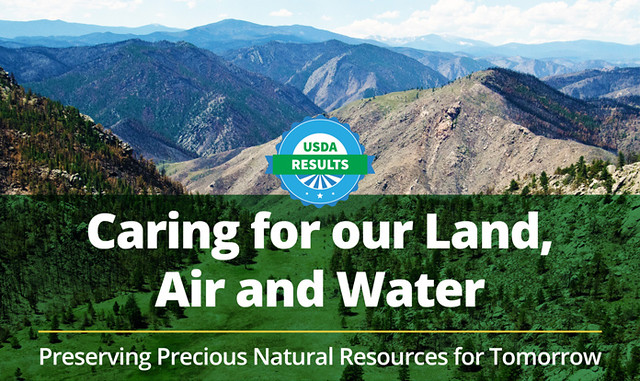
At the beginning of this year, we launched a year-long reflection on USDA-wide results achieved over the course of this Administration. This week begins a month-long focus on seven years of USDA accomplishments to preserve our natural resources for tomorrow’s generations – accomplishments that have only been made possible with the hard work of our staff at USDA and the support of our steadfast partners.
I’m proud of the work that we’ve done to build lasting partnerships to care for our nation’s unparalleled public lands and support producers as they conserve our nation’s land, water and soil. Please take some time to read a full story of our results on my Medium page at: www.medium.com/usda-results.
To kick off the month, here are 10 Big Data Points that show what we’ve been able to achieve with federal support and a strong commitment to our future.
1. America’s 193 million acres of public forests and grasslands supply the drinking water for 60 million Americans, support approximately 200,000 full and part time jobs and contribute over $13 billion to local communities each year.
2. Since 2009, USDA has invested more than $29 billion to help producers make conservation improvements, working with as many as 500,000 farmers and ranchers each year to implement conservation practices on a total of 400 million acres of farm, ranch and forestland.
3. Despite record drought, longer fire seasons and more than half of its budget spent fighting wildfire, the Forest Service and partners have increased the pace and scale of forest restoration by 9% since 2011 and increased timber harvest by 18% since 2008. In the past 5 years, the Collaborative Forest Landscape Restoration Program has treated more than 1.45 million acres to reduce the risk of catastrophic fire, generating more than 1.2 million board feet of timber, $661 million in local labor income and an average of 4,300 jobs annually.
4. To improve water quality, we’ve reduced nitrogen runoff from farm fields by over 3.5 billion pounds over the past 6 years and reduced phosphorus runoff by over 700 million pounds since 2009.
5. Since 1985, the Conservation Reserve Program has sequestered an annual average of 49 million tons of greenhouse gases, equal to taking 9 million cars off the road and prevented 9 billion tons of soil from eroding, enough to fill 600 million dump trucks.
6. Since 2009, we’ve helped America’s producers lead voluntary efforts to combat climate change that have reduced net greenhouse gas emissions by over 360 million metric tons or the equivalent of taking 12.6 million cars off the road per year. In April of last year, we also launched the Building Blocks for Climate Smart Agriculture and Forestry Initiative to give farmers, ranchers and forest landowners the tools and resources they need to continue to respond to climate change, with the goal of doubling our annual progress to 120 million metric tons of CO2 equivalent per year by 2025—the equivalent of taking an additional 25 million cars off the road each year.
7. We’ve put people to work and begun developing the next generation of conservationists with partners like the 21st-Century Conservation Service Corps to provide jobs and training opportunities to nearly 10,000 youth and veterans annually since 2014.
8. We launched the Regional Conservation Partnership Program (RCPP) in 2015 and heralded a new era of conservation. With USDA and matching partner investments, RCPP can invest $2.4 billion for conservation over 5 years.
9. Worked with farmers and ranchers to plant cover crops that build soil health and resilience on more than 3.7 million acres and to use no-till on more than 1.7 million acres since 2012.
10. Invested over $1 billion in programs in 2014 that help farmers, ranchers and our public forests mitigate and adapt to the impacts of drought.
